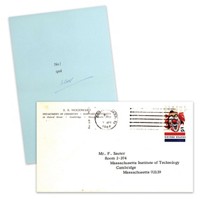Advertisement
Grab your lab coat. Let's get started
Welcome!
Welcome!
Create an account below to get 6 C&EN articles per month, receive newsletters and more - all free.
It seems this is your first time logging in online. Please enter the following information to continue.
As an ACS member you automatically get access to this site. All we need is few more details to create your reading experience.
Not you? Sign in with a different account.
Not you? Sign in with a different account.
ERROR 1
ERROR 1
ERROR 2
ERROR 2
ERROR 2
ERROR 2
ERROR 2
Password and Confirm password must match.
If you have an ACS member number, please enter it here so we can link this account to your membership. (optional)
ERROR 2
ACS values your privacy. By submitting your information, you are gaining access to C&EN and subscribing to our weekly newsletter. We use the information you provide to make your reading experience better, and we will never sell your data to third party members.
Education
Newscripts
Wrestling with Ph.D. posters and computerized coulda-beens
by Matt Davenport
June 27, 2017
| A version of this story appeared in
Volume 95, Issue 18
Pumping up posters

To put it bluntly, the posters that students usually use to announce their thesis defenses are lame, says doctoral student Chris Bialas of the University of Pennsylvania. So when he was preparing to defend, he opted for a flyer with a little more muscle.
His flyer still has all the standard information: the date, time, and location of his defense, along with its title, “The Design and Engineering of an Artificial Protein Magnetoreceptor.” What sets it apart, though, is the masked, muscular wrestler wearing a graduation cap and gripping a diploma.
“It’s so silly,” Bialas says of the flyer, which mixes pulp art with over-the-top machismo. “But I thought it would be cool to have something with more monster-truck style, something that said, ‘Sunday, Sunday, Sunday!’ ”
Bialas recruited Mary Leonard, a graphic designer in the university’s Biomedical Art & Design Center, and the tag team created the flyer using Photoshop and a poster Bialas had found taped to a street lamp in Philadelphia. The poster advertised a local lucha libre wrestling event, a popular style of professional wrestling developed in Mexico that is perhaps best known for its masked combatants. Bialas and Leonard changed the text and added academic accoutrements to the wrestler, or luchador.
“I think his name is Fire Ant,” Bialas says.
Although Bialas was not on his own poster, he did don a mask toward the end of his defense, which he passed. Had his defense missed the mark, promoting it with such an ostentatious flyer would have been a poor choice, but his committee seemed to enjoy it, he says. Beyond that, the flyer helped draw a standing-room-only crowd, garnered some attention on social media, and jibed with Bialas’s ethos.
“I think you’ve got to approach science with passion, but also with a sense of humor,” says Bialas, who will graduate in May.
Machine-learning wistfulness

Of course, Bialas is not the only scientist with a sense of humor. In fact, at least one writer on the Newscripts gang was nearly duped by an April Fools’ prank published by University of California, San Diego, physicist Eve Armstrong.
But we probably should have guessed from the title. “A Neural Networks Approach to Predicting How Things Might Have Turned Out Had I Mustered the Nerve to Ask Barry Cottonfield to the Junior Prom Back in 1997” is pretty outlandish, Armstrong says (2017, arXiv: 1703.10449).
“It’s ridiculously long,” she says, laughing, “and ridiculously ridiculous.”
The title—and the paper itself—are inspired by true events, however. Armstrong considered asking the pseudonymous Barry to junior prom 20 years ago and the paper has its roots in real science.
The publication is a by-product of Armstrong’s efforts to learn about artificial neural networks, computer algorithms with a penchant for pattern recognition. Neural network approaches, for instance, are big in facial recognition software, she explains. Researchers show the programs photos of so many faces that the algorithms learn to recognize the patterns in visual data that are consistent with something being a face. The programs can then look at photos they’ve never seen before and pick out the faces.
Armstrong, however, has a different goal. As a postdoc in Henry Abarbanel’s research group, she studies artificial neural networks to try to understand how nature has connected the neural circuits that control some of life’s most basic functions.
Although Armstrong’s working on serious science, it seemed only natural for her to write a parody paper inspired by it. After all, she has a history of academic April foolery, including another publication titled “Nondetection of the Tooth Fairy at Optical Wavelengths.”
Matt Davenport wrote this week’s column. Please send comments and suggestions to newscripts@acs.org.





Join the conversation
Contact the reporter
Submit a Letter to the Editor for publication
Engage with us on Twitter